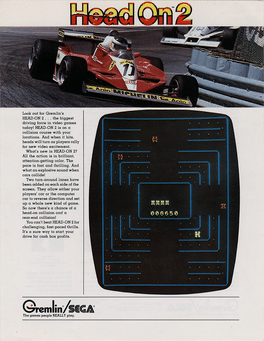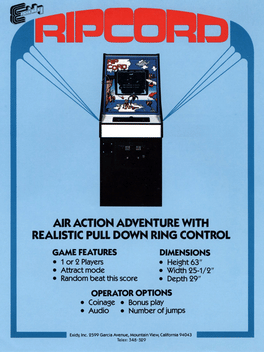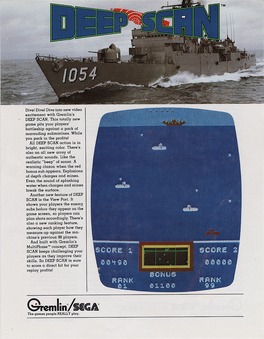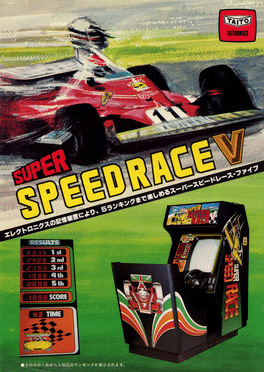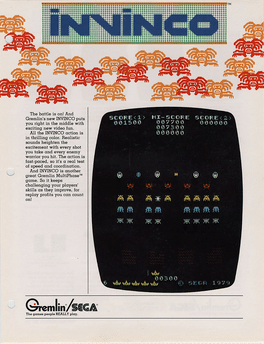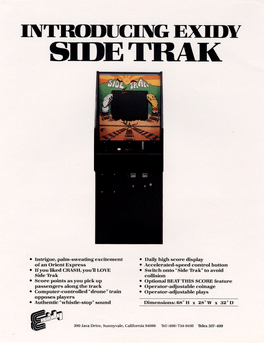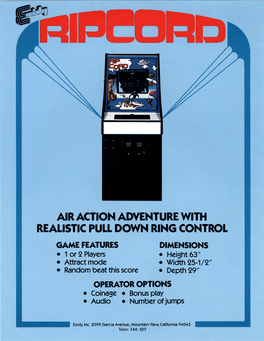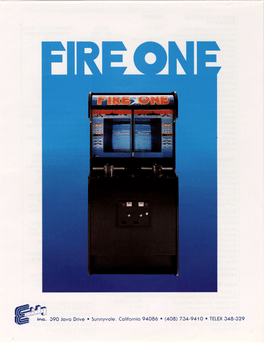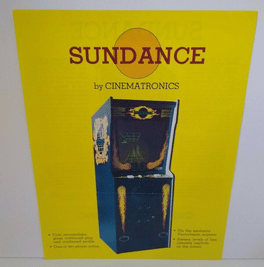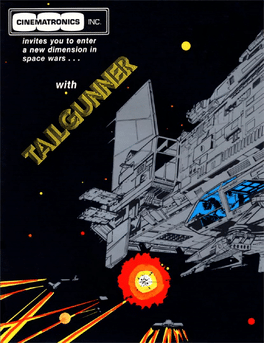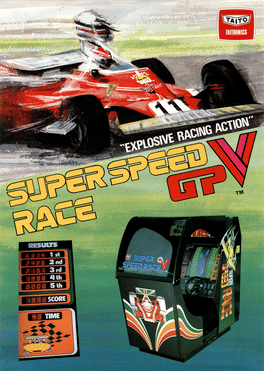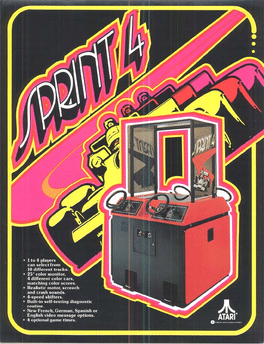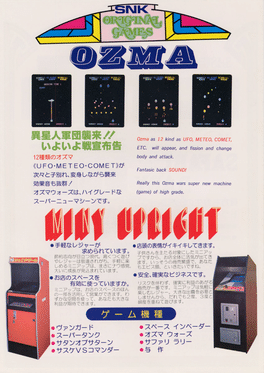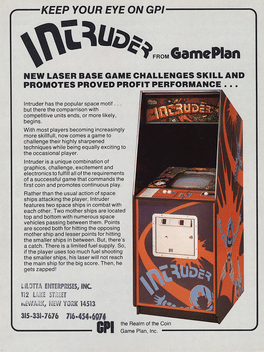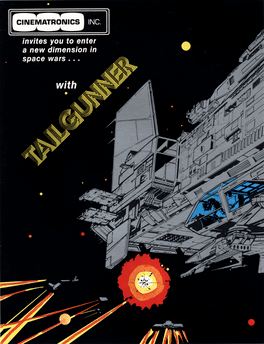New Arcade Games - Page 132
-
Head on N
1979
Head on N
1979
Head On N is an arcade video game released by Nintendo in 1979. The game is a licensed clone of Sega's arcade game Head On. Head On N is a maze game in a similar vein to Pac-Man that has the player controlling a car, collecting dots and avoiding the other cars in the maze in order not to crash (the other cars act as the ghosts from Pac-Man). -
Head on 2
1979
-
Ripcord
1979
-
Sheriff
1979
-
Deep Scan
1979
-
Super Speed Race V
1979
-
Invinco
1979
-
Side Trak
1979
Side Trak
1979
Side Trak is a black & white man-versus-machine game where the goal is to pick up all of the waiting passengers with your train while avoiding the computer-driver "killer engine" which aims to take you out in a head-on collision. You can control your train via the "fast" button which allows you to temporarily increase your speed on the tracks. You can also use the joystick to switch between several tracks at various junction points. Each time you make a complete circuit around the track and pass the start marker on the outside track, another car is added to your train. Passengers picked up from the outermost track are worth 10 points. Passengers picked up from each successive inner track are worth an additional 10 points. On top of that, passengers picked up when you have additional cars in tow add another 10 points to car. Side Trak is the first of several games that were developed on a common Exidy platform which would eventually become host to their most popular games. Early revisions of the platform — Side -
Rip Cord
1979
Rip Cord
1979
Rip Cord was another black & white game released by Exidy in 1979. It was designed and programmed by Arlan Granger. The goal of the game is to jump out of the plane and land safely on one of the many targets down below. The challenge is to avoid the numerous enemy helicopters that occupy the sky in between your plane and the ground. You control the timing of your jump with the Jump button, at which point your parachutist begins hurtling toward the ground out of control. Pressing the D-Ring button shortly afterwards releases the chute and slows your descent. More importantly, it allows you at this point to control your left/right position via the paddle control to help you avoid the enemies. -
Fire One
1979
Fire One
1979
Fire One! was a player-versus-player or player-versus-computer submarine showdown, designed and programmed by David Rolfe, Ted Michon, and Susan Ogg for Exidy in 1979. The cabinet was split into two halves, with each player controlling their first-person submarine perspective on their half of the screen. The primary objective of the game is to find and destroy the enemy's submarine, while avoiding the enemy's torpedoes. Through your virtual periscope you are free to launch one of your 8 torpedoes to take out any of the enemy's various ships for extra points. It takes some time to reload each torpedo tube, so you must be judicious in how you plan your attacks. In addition to being able to control the left/right rotation of your periscope, the game also features a submerge button which you can use to temporarily hide from the enemy. Holding this button down keeps you hidden but also keeps you out of the action, allowing the enemy free reign over the seas. -
Sundance
1979
-
Tailgunner
1979
Tailgunner
1979
As a tailgunner the player tries to defend his plane while shooting down the aproaching enemy aircrafts. -
Sprint 4
1979
-
Ozma Wars
1979
Ozma Wars
1979
Ozma Wars is a 1979 fixed shooter arcade game, and the very first game developed and published by SNK, who were still known as "Shin Nihon Kikaku" at the time. The game is also known as the second ever vertical shoot 'em up game, after Taito's Space Invaders (which ran on the same arcade hardware), but is also additionally known as the first game with disparate "levels". The game is also notable for being the first action game to feature a supply of energy, resembling a life bar, a mechanic that has now become common in the majority of modern action games. The game allowed the player to refuel energy between each level, and it featured a large variety of alien enemies. The player controls a space craft which must fend off UFOs, meteors, and comets. Instead of lives, the player is given an energy reserve that is constantly diminishing; getting hit by the enemy causes gameplay to stop momentarily and a large amount of energy is depleted. Every so often, a mothership will appear and dock with the player's spacecraft, -
Intruder
1979
Intruder
1979
Intruder is an arcade game originally released by Konami as Space War. It is a one-on-one spaceship combat game with each player controlling a ship at the top or bottom of the screen. Between the players is a stream of innocent space ship traffic limiting the possibility of getting a clean shot. When your fuel reaches a high number (like 75 or so) your laser will reach the other side of the screen to get your opponent. Once you fire your laser your fuel drops sharply and you must wait for it to build before you can shoot at your opponent again. Space War is Konami's first known original video game design. It was licensed by Taito, who released it as Space Laser (in Europe), and by Game Plan, who released it as Intruder (in North America). -
Tail Gunner
1979
Tail Gunner
1979
Tail Gunner is vector arcade game created by Vectorbeam in 1979. As enemy space craft attack the player, they must aim a set of cross-hairs and shoot the enemies before they move past the player's laser cannons or use shield to bounce them back into play. -
Space Launcher
1979
Space Launcher
1979
Space Launcher is an arcade video game by Nintendo that was surprisingly original (many of the games Nintendo made during the late '70s were clones of popular titles like Pong, Space Invaders and Breakout). The game is similar to Frogger, though is not a clone since it predates it by at least two years. The game takes place in space, and your goal is to maneuver around space objects and dodge oncoming enemy fire from the aliens that are stationed above. There are also treasures at the top, and your goal is to fly up, grab the treasure, and come soaring back down after which you must repeat it until all of the treasures have been scavenged. The game's poster seems to be inspired slightly by the Star Wars films, which were very successful at the time of this game's release. Even the yellow font of this game's logo could be said to be based on Star Wars' logo. -
Lunar Rescue
1979
Lunar Rescue
1979
The game starts with the player's spacecraft docked inside the mothership at the top of the screen. Below the mothership is an asteroid field and below that, the surface of the moon. There are three platforms which can be landed on and six stranded astronauts that need rescuing. You control a small spacecraft. The player must press the button to release their spacecraft from the mothership and manoeuvre through the asteroid field. The craft can only move left or right or use up a finite amount of fuel by engaging the thrust (the same button again) to slow its descent. If the craft is landed successfully on one of the available platforms, one of the astronauts will run towards and board the craft. The asteroid belt now changes into a swarm of flying saucers, some of which drop bombs. The player must now guide the spacecraft back up to the mothership (the craft ascends without using up fuel), avoiding the flying saucers. The thrust button is now a fire button which can be used to shoot at enemies above (as in Space -
Space Ship
1979
Space Ship
1979
Space Ship is an early arcade video game from Konami. It is a clone of Exidy's Star Fire, a first-person space combat game.

